Cats, often branded as aloof and solitary creatures, are much more than they seem. Beneath their composed exteriors lies a rich tapestry of emotions and an innate need for companionship. As cat owners, it is essential to grasp the subtle signals our feline friends convey, as these can lead to a deeper connection and more fulfilling cohabitation. In this article, we will explore various behaviors exhibited by cats and how to respond effectively, ensuring a harmonious relationship that centers around love, trust, and mutual respect.
Cats are adept communicators, but their language may not always be intuitive to a human observer. One unmistakable gesture of feline affection is bunting—when a cat gently bumps its head against you. This is not merely a playful act; rather, it is a form of scent marking that indicates both affection and a desire for closer bonds. When your cat displays this behavior, it signals that you are part of their inner circle, and the best way to respond is with gentle strokes or an inviting cuddle. This exchange fosters trust and validates your cat’s feelings.
Another telling sign is when your cat shadowing your every step. This behavior underscores a fundamental need for companionship. Whether you are shifting from one room to another or lounging on the sofa, your cat relishes your presence. Being there for your cat during these mundane moments strengthens their sense of safety and security. Consider setting aside moments for simply existing together, as these understated interactions contribute significantly to the emotional well-being of your pet.
The Symphony of Vocalizations
Felines use vocalization to express their needs and desires. An increase in meowing or chirping often signals that your cat requires your attention—be it for playtime, food, or affection. To decipher the intention behind these vocalizations, observe the context in which they occur. For example, a cat that meows as you approach the food bowl might be hungry, whereas one that chirps while looking at a toy may be inviting you to engage in play. Attending promptly to these calls not only answers their immediate needs but creates a shared experience of understanding and closeness.
Moreover, the act of slow blinking is a unique form of communication that feline enthusiasts adore. When a cat gazes at you and then gently closes its eyes, it’s akin to saying “I love you” in cat language. Mimicking this behavior can be incredibly rewarding—returning their slow blink can reinforce feelings of connection and appreciation. This simple yet profound exchange elevates the emotional bond you share, bringing warmth into your interactions.
Playtime as a Love Language
Cats often express their affection through play, presenting toys or, in some unfortunate instances, recent catches as offerings. These gifts are invitations for engagement and signify trust and a desire for interaction. When your cat shares these treasures with you, it is crucial to embrace the opportunity and initiate playtime. This not only satisfies their instinctual needs but also solidifies your relationship as one defined by mutual joy and shared activities.
Kneading is another common behavior among cats that often goes unrecognized. This comforting motion involves pushing their paws alternately against a soft surface and usually indicates that your cat feels safe and content. When you see your cat kneading beside you, take the moment to enhance this bonding experience with gentle caresses or by providing a cozy blanket. Such small acts of love reinforce their inherent desire for connection.
A significant indicator of trust in cats is their choice of resting place, particularly when they select your lap or snuggle close to you while sleeping. In this vulnerable state, your cat demonstrates profound trust and comfort—traits that speak volumes about the bond you’ve built together. Creating a nurturing environment that encourages these restful moments will not only enhance your cat’s feelings of security but also deepen your emotional connection.
Demonstrating belly exposure is another clear sign of your cat’s comfort level. While some cats relish belly rubs, others may simply want to stretch out and show you that they feel secure in your vicinity. It is crucial to be sensitive to your cat’s individual preferences; a gentle stroke of the belly can elicit ecstatic reactions or, conversely, a defensive response. Being attuned to your cat’s personality is vital for nurturing a fulfilling interaction.
Understanding your cat’s subtle cues and responsive behaviors is pivotal to nurturing a loving relationship. By recognizing their wants and needs, you can foster a world filled with affection and trust. Each interaction, whether through play, affection, or gentle communication, enriches the bond between you and your feline companion. Embrace the opportunity to engage more with your cat, and allow the unique nuances of their personality to shine through. Your efforts will undoubtedly lead to an enriching and gratifying relationship that benefits both you and your beloved pet.

